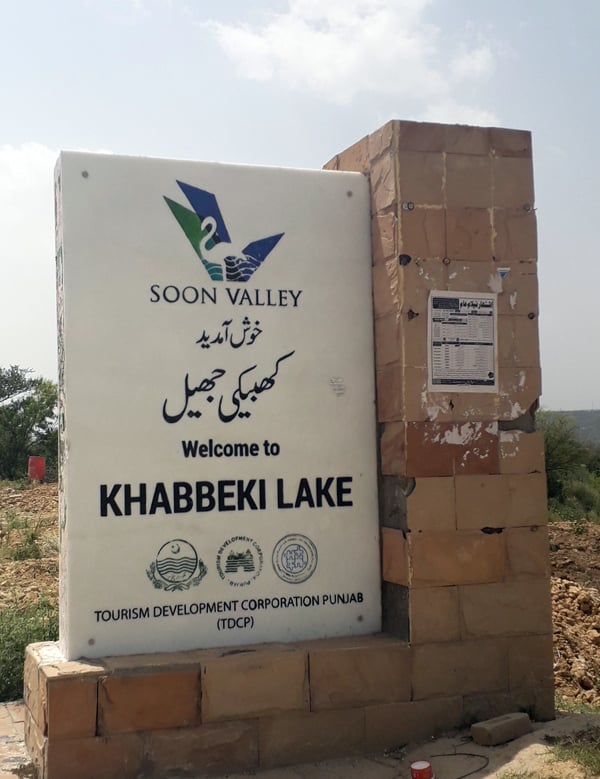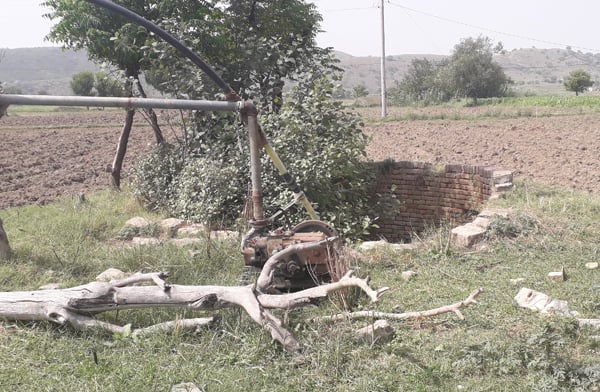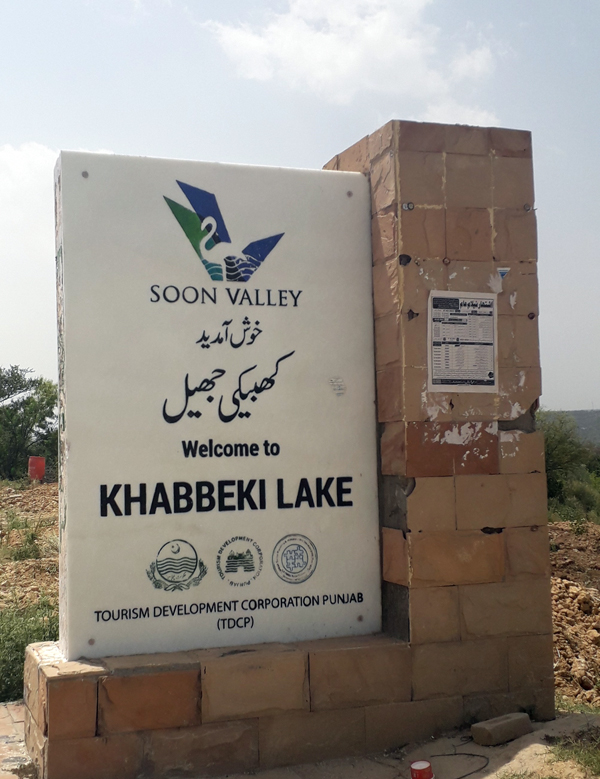Karachi: Son Valley of Koh Namak is considered a beautiful tourist destination due to the surrounding mountains, beautiful lakes and the large number of birds landing on the shores and tourists from all over the country are drawn here, but climate change has affected this very unique ecosystem (Eco system) has also been compromised.
The southern edge of the Potohar Plateau is demarcated by Pakistan’s famous Salt Range, which stretches from Mianwali in the west to the Jhelum in the east. It is called Koh Namak because the second largest salt deposit in the world was discovered here. These salt deposits were the result of the collision of the Indian Plate with the Asian Plate 50 million years ago, evaporating the Tethys Sea and creating the Indus River Plains.
The western edge of Koh Namak forms a semicircle that creates the Son Valley. The elevation in the middle of the valley is 2,000 feet above sea level. The salt water lakes located here are of international importance. These lakes are home to birds from Siberia, including the critically endangered heron.
The water complex of Koh Namak consists of Kaler Kahar, Khabiki, Uchali, Jhalar and Nimal lakes. This area is also the habitat of Punjab Uryal, a type of local sheep.
The Khabiki area is salty and muddy and is very attractive to many bird species in winter, including the endangered white-headed duck. The number of birds visiting the lake has also decreased in the last few years. Because the fragile biodiversity of this water area has been severely damaged by the overfishing of birds and fish and the lack of water in the lakes. Uchali Lake also holds brackish water and is an ideal habitat for migrating leeches. Every year these birds stay here for 3 to 4 months and gather energy to continue their long journey. Khabeki, Uchchali and Jhalar are considered part of the Uchchali complex and in 1996 it was recognized as a Ramsar site.
The Uchchali complex was declared a wildlife sanctuary in 1966. Ten years later, when Pakistan joined the Ramsar Convention in 1976, due to the arrival of rare birds, these lakes were given the status of a Ramsar site, i.e. a water body of international importance. The number of these lakes in Ramsar sites is 818. The Ramsar Convention gives more importance to the wetlands where endangered animals, birds and plants are found.
The most important visitor birds from the cold regions of Siberia are white-headed ducks, whose species are now threatened with survival. Apart from this, Lim Dheng, Stork, Chatkabra Stork, Qaz, White-eyed Rooster, Gray Vulture and Imperial Eagle are also found in this area. Fish are also found in these lakes. Depletion of water in lakes due to changing climates along with large-scale deforestation in the area has also posed a major threat to birds.

It was the last week of June when we got a chance to see the Son valley and its beauty up close, the trip for journalists was organized by the Institute of Urbanism, a think tank in Islamabad. was to look at the impact of several management projects, particularly rainwater harvesting techniques, which have helped local populations cope with increasing water needs.
It was the third week of June in which the temperature touched 35 degrees Celsius while the feeling touched 42 degrees Celsius. This intensity of seasons was definitely an indicator of climate change. Now, probably every Pakistani knows that Pakistan is on the top 10 list of countries affected by climate change. This year also our number is fifth.
A 50 km drive through a narrow and mostly uneven road took us from Khushab district to Wadi Soan. The road was sparkling with the strong sunlight in the afternoon as tall poplars on both sides failed to block the sun’s path.
Although temperatures in the valley were 3 to 5 degrees Celsius cooler than the capital Islamabad and even the adjacent Khushab city, it was still warm, reflecting the increasing ravages of climate change.
Our first destination was Uchchali Lake, the largest of the lakes and containing salt water, long a favorite destination of Siberian birds that migrate from Siberia every year to escape the harsh winters.
However, the number of migratory birds has decreased significantly in recent years due to boating and other water sports activities in the lake.
Agriculture, mainly vegetable cultivation is the main source of livelihood of the local people. Large and small fields of cauliflower, potatoes, green chillies and other vegetables were spread on both sides of the road.
The large production of vegetables, equivalent to two to three crops annually, has significantly increased the income of local farmers.
However, this revenue growth has a downside. Large-scale cultivation of vegetables, especially cabbage and cabbage, which require a lot of water, has depleted groundwater levels in recent years, creating water shortages across the region. It’s done.
Rainwater harvesting
Rainwater and mountain springs are the two major sources of drinking water for the local people as the lake water is brackish and not suitable for drinking or agricultural purposes.
Local farmers depend on tube wells and rainwater for cultivation, which has resulted in rapid depletion of groundwater levels.
Realizing the declining groundwater levels and water scarcity, the World Wide Fund for Nature (WWF) Pakistan last year launched a variety of projects to address future water management challenges in the region, particularly Rainwater harvesting techniques.

Rainwater harvesting is a technique used to collect, convey and store rainwater for future use from relatively clean surfaces such as rooftops, ground surfaces or rock catchments.
It consists of five major components. Catchment (used to collect and store rainwater), Conveyance system (used to transport the stored water from the catchment to the recharge zone), Flush (the first spell of rain for extraction), filters (used to filter collected rainwater and remove pollutants), and tanks and recharge structures (used to store filtered water for use ready for).
So far, around 16 rainwater harvesting units with a capacity of 1300 cubic meters per year have been set up in the area, with WWF planning to increase the number to 34 in the next two years.
These units are set up in the vicinity of lakes to prevent excess rainwater from entering the reservoirs and diluting them with saline water.
Outlining the benefits of the project, Umar Bin Khalid, a senior environmentalist associated with WWF-Pakistan, said the technique is cost-effective, and besides promoting both water and energy conservation, reduces water bills. It helps.
However, he added, its installation requires some technical skills.
Ablution water reuse system
The ablution water reuse system is primarily designed to treat and recycle water used for ablution purposes in mosques.
It is estimated that a mosque with about 500 worshipers reuses an average of 2.5 cubic meters of water per day.
The water is passed through a sand and gravel filter to remove small particles and disinfect.
The purified water from ablution can be used for irrigation, gardening, lawn washing, for all purposes except drinking.
The ablution water is relatively clean and has less physicochemical and biological pollution.
So far, two ablution water reuse systems have been installed in the area with a capacity to purify 4,500 cubic meters of water per year.
Two more systems will be installed in the coming months.
“The benefits of ablution water treatment plants are numerous. It conserves water resources by reducing wastage, reduces environmental pollution by preventing the discharge of untreated water, and promotes hygiene and sanitation,” added Khalid.

In a small Mardwal village, one of the 36 villages in the Son Valley, and located a few kilometers from the Uchali Lake Complex, WWF has introduced another project, the Floating Treatment Wetland (FTW). Commonly referred to as a floating water treatment system.
The technique is widely used in Europe and other regions around the world, floating treatment is a type of wetland water treatment system that uses floating platforms of plants to remove pollutants from water bodies.
Floating treatment wetland designs vary depending on the water quality, types of pollutants present, and desired cleanup goals.
FTW involves placing a mat, or foam, on the surface of the water and planting it with wetland plants. As plants grow and roots spread through the water, they absorb nutrients and various pollutants.
An average of 19,000 cubic meters per year of wastewater is estimated to be treated by a floating treatment wetland installed in a wastewater pond with a size of one acre and a depth of one meter.
“It is a relatively low-cost method for water purification and reuse, but it has limited ability to remove certain contaminants, such as heavy metals and soluble salts,” Khalid said.
FTW improves water quality and prevents runoff and erosion, as well as providing habitat for wildlife including fish, birds and insects.
However, this system has some disadvantages. It is vulnerable to extreme weather conditions and can be damaged during storms or high winds.
According to a WWF official, there is limited research and data on their long-term effectiveness and environmental impact.
The two FTWs, which have been installed so far, have a capacity to treat about 49,000 cubic meters of water per year.
In the middle of a vast field, in the hot afternoon sun, Malik Wasim was briefing visiting journalists about the agency’s groundwater recharge project, which aims to combat urban floods and droughts by recharging groundwater. Have to find
He said that the four artificial groundwater recharge wells constructed recently have the capacity to recharge about 31,000 cubic meters of water annually.
WWF plans to construct four more groundwater recharge wells in the next two years, according to Wasim, project coordinator.
“These numbers may seem small but their impact in terms of changing the lives of the local population is huge,” said Dr. Ijaz Ahmed, an experienced environmentalist and senior program fellow at the Institute of Urbanism, who said that dams and canals Big water management projects including water management have their importance, but these small initiatives also have an importance, considering the fact that it is cost-effective, easy to implement and free from politics.
(function(d, s, id){
var js, fjs = d.getElementsByTagName(s)[0];
if (d.getElementById(id)) {return;}
js = d.createElement(s); js.id = id;
js.src = “//connect.facebook.net/en_US/sdk.js#xfbml=1&version=v2.3&appId=770767426360150”;
fjs.parentNode.insertBefore(js, fjs);
}(document, ‘script’, ‘facebook-jssdk’));
(function(d, s, id) {
var js, fjs = d.getElementsByTagName(s)[0];
if (d.getElementById(id)) return;
js = d.createElement(s); js.id = id;
js.src = “//connect.facebook.net/en_GB/sdk.js#xfbml=1&version=v2.7”;
fjs.parentNode.insertBefore(js, fjs);
}(document, ‘script’, ‘facebook-jssdk’));



